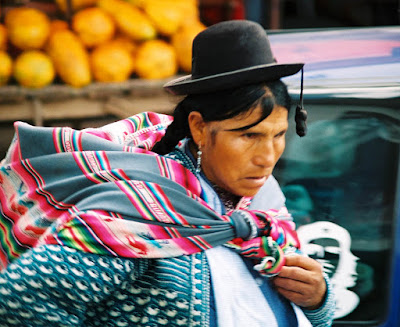Massacre in Peruvian Amazon over US Free Trade Agreement
Student Researcher:
- Kelsea Arnold (Sonoma State University)
Faculty Evaluator:
- Eric McGuckin (Sonoma State University)
On World Environment Day, June 5, 2009, Peruvian Amazon Indians were massacred by the government of Alán García in the latest chapter of a long war to take over common lands—a war unleashed by the signing of the Free Trade Agreement (FTA) between Peru and the United States.
Three MI-17 helicopters took off from the national police base in El Milagro, Peru, at 6 a.m. on Friday, June 5, and flew over part of the Peruvian highway that joins the jungle to the northern coast, which had been occupied for the past ten days by five thousand Awajún and Wampi indigenous peoples.
The helicopters launched tear gas on the crowd (witnesses say they also shot machine guns) while a group of agents simultaneously attacked the roadblock by ground, firing AKM rifles. An estimated five hundred police bore down on the protesters, some of whom were still sleeping, and opened fire. A hundred people were wounded by gunshot and between twenty to twenty-five were killed.
The government claimed days after the clash that eleven indigenous were dead as well as twenty-three police agents. The indigenous organizations reported fifty dead among their ranks and up to four hundred disappeared. According to witnesses, the military burned bodies and threw them into the river to hide the massacre, and also took prisoners from among the wounded in hospitals. While accounts differ, what is certain is that the government sent the armed forces to evict a peaceful protest that had been going on for fifty-seven days in five jungle regions: Amazonas, Cusco, Loreto, San Martin, and Ucayali.
The conflict began on April 9, when Amazon peoples mobilized to block the highways and gas and oil pipelines to protest the implementation of a series of decrees passed to carry out the FTA with the United States. But the situation worsened on June 4, when García’s government stopped Congress from debating repeal of the decrees being challenged by the indigenous peoples and declared unconstitutional by a Constitution Commission.
The US–Peru FTA was signed on December 8, 2005, in Washington, DC, by then presidents George W. Bush and Alán García. In June 2006, it was ratified by Peru, and in December 2007 by the US Congress. On December 19, 2007, Peru’s Congress gave full faculties to the government to legislate for six months by decree issues related to the FTA. Mandated by these powers, the executive drafted ninety-nine legislative decrees (LD) that are at the root of the current conflict. On February 1, 2009, the agreement went into effect.
In response to indigenous protests President García said there was “a conspiracy afoot to try to keep us from making use of our natural wealth.” He was referring to the fierce opposition by the country’s native peoples to ten of the ninety-nine LDs issued by his government that open up indigenous land to private investment by oil, mining, and logging companies, as well as to agribusiness, including biofuel plantations.
The most controversial of the LDs are numbers 1015 and 1073. These decrees, which were declared unconstitutional, modify the number of votes required to sell communal lands (just three votes could place community land up for sale).
LD 1083 (Promotion of Efficient Use and Conservation of Hydraulic Resources) favors the privatization of water to large consumers such as mining companies. LDs 1081, 1079, and 1020 deregulate diverse aspects of legislation in areas of mining, timber, and hydrocarbon exploitation.
It is LD 1090 (Forestry and Woodland Fauna Law), however, that is at the crux of the debate. This decree leaves 45 million hectares out of the forestry framework, that is, 64 percent of the forests of Peru, including their biodiversity in flora and fauna, making it possible to sell this vast commonwealth to transnational corporations.
Based on his logic of converting everything into merchandise, García maintained, “The first resource is the Amazon.” He proposed to divide 63 million hectares into 5,000-, 10,000-, and 20,000-hectare parcels—as land sold in “large lots will attract long-term investment and high technology.” He notes that one should not “deliver small lots of land to poor families that do not have a penny to invest.” He makes no mention of the fact that these lands are the collective property of native communities.
On April 9, over one thousand communities agreed to start demonstrating. Prime Minister Yehude Simon called the April 18 indigenous demands “capricious.” On May 5, the bishops of eight Catholic dioceses demanded that President García repeal the decrees, declaring them “a threat to the Amazon.” On May 10, the government announced a state of emergency in five regions of the country where roadblocks and blockages of ports and oil pipelines were taking place.
Hugo Blanco, a well-known Peruvian activist and editor of the monthly Lucha Indígena, stated in his column: “After 500 years of silencing, the Amazon peoples receive the support of the peoples of Peru and the world. The greatest achievement of this campaign has been to make these nationalities visible, weaving links between diverse sectors of the country, as divided as those who dominate. By defending the Amazon we are defending the life of all of humanity; and by not ceding to the deceit of the government, they are rewriting history, recuperating for all the sense of the word dignity.”
Sources:
Raúl Zibechi, “Massacre in the Amazon: The US-Peru Free Trade Agreement Sparks a Battle over Land and Resources,” trans. Laura Carlson, Americas Program, Center for International Policy, June 16, 2009, http://americas.irc-online.org/am/6191.
Milagros Salazar, “‘Police Are Throwing Bodies in the River,’ Say Native Protesters,” Inter Press Service, June 9, 2009, http://ipsnews.net/news.asp?idnews=47142.




Comments